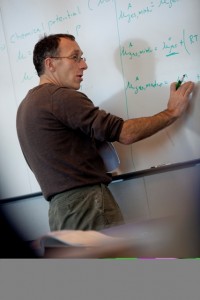
Professor Steven Mylon
You could say Steve Mylon, assistant professor of chemistry, enjoys testing his mettle on the road of life.
Take for example the time he pedaled his bike 3,500 miles across the country, crossing into Canada for a tour of Ontario before dipping back into the wilds of northern Michigan and then continuing on to Seattle’s waterfront. West to east is an easier route, but Mylon chose to travel against the wind, battling at times 40 mph gusts on the bulky frame of a mountain bike.
“I pick things to do based on whether it’s a good challenge,” says Mylon, who doubled majored in Soviet-Eastern European studies and chemical engineering at Tufts before earning a Ph.D. in experimental physical chemistry from Dartmouth College in 1998.
These days, Mylon’s cycling is confined to rides around the block with his two young sons, yet he’s still exploring new terrain through research into nanotechnology, the ability to manipulate very small particles. This new science has applications in many fields including medicine, computers, food, and textiles. But the environmental implications of nanotechnology are still unknown, says Mylon, who is collaborating with researchers from around the world on potential hazards of the technology.
For instance, antibacterial silver nanoparticles are being embedded in socks, shirts, bandages, washing machines, and other products to counter bacteria and get rid of smelly odors. But what happens to the chemical reactivity of nanoparticles when they’re released into the environment?
“If they have antibacterial properties, that’s fine for the smelly guy, but how do the nanoparticles affect the naturally occurring bacteria and microorganisms?” says Mylon. “Could they accumulate in sediments or be taken up by smaller microorganisms eventually finding their way into the water stream? These are questions that won’t be answered for a long time.”
The end goal is not to repeat the mistake made with Freon, a compound invented in the 1930s that was hailed as a safe alternative to the toxic gases used to cool refrigerators. But what scientists didn’t know, and wouldn’t find out until many years later, is that the chlorofluorocarbons that make up Freon contributed to the depletion of the ozone layer, Earth’s protective shield.
“Environmental chemists have an opportunity to study the environmental implications of nanomaterials while the industry is in its infancy,” says Mylon.
His involvement with environmental causes extends beyond his research, a byproduct of his bike ride, when he took a closer notice of the natural world.
As adviser to the Society of Environmental Engineers and Scientists (SEES) at Lafayette, Mylon is working with students to create a sustainable food loop by growing organic produce for use in campus dining facilities and then taking the leftover food scraps and turning them into compost for the campus garden. The group received a $10,000 EPA grant for the project and will compete next month in the National Student Design Competition for Sustainability in Washington, D.C. for a $70,000 grant to implement the idea in surrounding communities. The group has been awarded other grants as well for its work with arsenic in drinking water and the design of a green roof on Acopian Engineering Center.
The group’s success is not only a credit to the passion of the students involved, but also to the liberal arts education at Lafayette because they’re being trained to tackle problems from different viewpoints and areas of expertise.
“The field of environmental science is so interdisciplinary,” Mylon says. “It requires looking at a problem through many different lenses.”
The possible removal of Easton’s Bushkill Dam, which Mylon is studying with other faculty and students, is a case in point. Dam removal causes changes in the river and unleashes a flood of sediment into the water. Students are working to predict how much sediment would be released if the dam is removed and then analyzing the materials to see what impact they might have on the environment. They’re also mapping the channel, collecting core samples, and then considering conflicts between economic development and environmental conservation.
“We’re not just looking at it from an engineering standpoint, but engaging chemists, biologists, and policy people,” he says.
It’s also a great way for students to apply what they’ve learned in the classroom to existing environmental problems and gain a sense of whether they’re majoring in the discipline that’s right for them. Sometimes, however, fate intervenes, as in Mylon’s case when the Iron Curtain fell just as he was considering the pursuit of an advanced degree in Soviet and Eastern European studies.
“The field as I knew it was changing pretty rapidly and its future and my future in it did not seem as certain as it once was,” he says.
He then decided to reconnect with the sciences and became more passionate about chemistry. So he switched course and got a job teaching chemistry and physics at Phillips Academy in Andover, Mass. After five years, he began his Ph.D. program at Dartmouth and from there did a postdoctoral fellowship in environmental chemistry at Yale University in 2000.
His career at Lafayette began in 2004, two days before his wife gave birth to their first son. But multi-tasking has never been a problem for Mylon, who says Lafayette not only demands its faculty be excellent teachers, but leaders in their fields. It’s a duality Mylon enjoys, noting that his research enables him to challenge and engage students in unique ways.
“I’m not here to direct anyone’s life,” he says. “I’m here to give them a flavor of the chemistry I’m teaching. I can’t expect students to love everything in the lab like I do, but I try to provide classes and experiences that offer the best possible experiences.”
